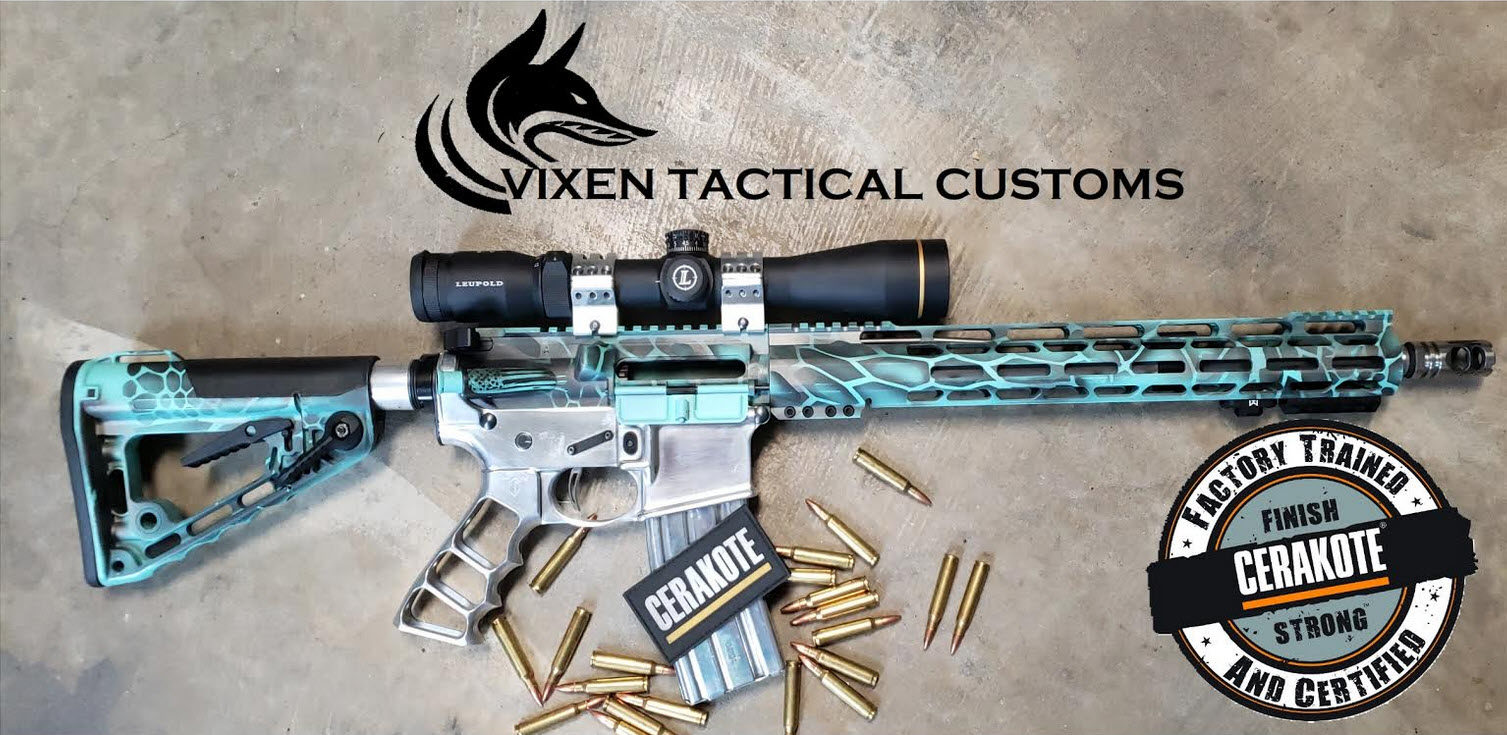Latest and most popular cerakote colors here:
https://www.cerakote.com/finishes/?tab=coatings&cat=HSERIES
Cerakote colors on bolt action rifles:
https://www.cerakote.com/gallery/?tab=trending&orderby=trending&htids=2335
Cerakote colors on AR-15 rifles:
https://www.cerakote.com/gallery/?tab=trending&orderby=trending&htids=2120
Cerakote colors on AK rifles:
https://www.cerakote.com/gallery/?tab=trending&orderby=trending&htids=7029
Cerakote colors glocks:
https://www.cerakote.com/gallery/?tab=trending&orderby=trending&htids=609
Cerakote browns:
https://www.cerakote.com/gallery/?tab=color&color=cgbrown%2Ccgbrnz%2Ccgtan
What materials can you Cerakote?
Cerakote can be applied to most substrates including but not limited to: Aluminum, steel, titanium, brass, copper, chrome plating, glass, polymers, plastics, wood, and even some fabrics! Depending on the series used, baking may or may not be required allowing items and materials that cannot be oven cured to still be coated. The H series and Elite series can be baked at lower temps on a longer cycle as needed. C series is the air cured version good for fabrics, plastics, temperature sensitive materials, electronics etc.
Which is better Duracoat or Cerakote?
Both offer good protection and looks, however in our testing and experience Cerakote is superior in corrosion resistance, durability, hardness, color choice, color matching of factory applied cerakote, uv stability, adhesion, and temperature resistance.
Can you Cerakote a synthetic stock?
Yes you can! Or anything polymer/ plastic that can be prepped and cleaned properly without damaging the material. An example of this would be any plastic, polymer, or rubber that is soft or too flexible for the coating to fully harden and remain durable.
What are the pros and cons of nickel plating, bluing, nitriding, parkerizing, cerakoting or duracoating a firearm?
There is no simple answer to this and depends immensely on the application for the firearm or parts being coated. Nickel boron or nibx coatings are primarily used on low friction contact points such as bolts, bolt carriers, charging handles, trigger groups and anywhere a slippery almost polished contact surface is needed. Nickel plating has been used a long time on some firearms where a unique look is desired, engravings, or better corrosion resistance than steel is needed.
Bluing is one of the oldest methods of firearms protection. It looks great, and has plenty of applications. However it offers little abrasion resistance, and can be chemically sensitive, moisture sensitive, and needs periodic maintenance to keep its corrosion resistance.
Nitriding, aka melonite, parkerizing, Tin/ titanium nitriding, etc.. offers a chemical bond into the metal substrate. This makes for a very durable, hard wearing, and corrosion resistant treatment. It does require extended cleaning and prep even on new parts to achieve a proper bond and/or look. The applications are usually limited to small hard wearing parts that see a lot of contact or friction. Even barrels , chambers, bores, and bolts all benefit from these coatings. It is limited in colors, ease of application, and substrate compatibility.
Duracoat, Gun coat, poly coat, etc.. are popular gun coatings. They must be applied on top of an acceptable substrate. The colors are limited compared to cerakote at present. The ease of use for “diy” type applications is appealing to those wanting to refinish their own parts. The application choice needs to be seriously considered due to tolerances, heat resistance, corrosion resistance, color stability and chemical resistance when compared to Cerakote.
Cerakote has more color choices and application choices than any other firearm coating available. There is a product series available for plenty of applications other than firearms as well. It has been tested extensively as shown and documented and is currently in use my more manufacturers than any other firearms or high temperature ceramic coating worldwide. Cerakote offers temperature resistance anywhere from 300 to 2000 degrees depending on the series.
Click Here To View The CERAKOTE Product Series Guide
Cerakote continues to innovate, and test their products resulting in a superior product for your application!
How is Cerakote useful for guns?
Cerakote has the leading advantage of being a “thin film” coating. This makes it ideal for close tolerance parts found on almost every firearm! Temperature resistance up to 500 deg. on most firearms ensures durability and adhesion when it counts.This combined with ceramic technology offers a highly wear resistant coating while maintaining functionality and reliability. Then there are the almost endless color choices, custom mixes, and professional applicator network! As if this wasn’t enough, it also offers superior corrosion resistance,chemical resistance and uv stability.
Please don’t take our word for it, take a look at the test data found here: https://www.cerakote.com/testing/
What Is Cerakote?
Cerakote is a Polymer-Ceramic Composite coating that can be applied to metals, plastics, polymers and wood. The unique formulation used for Cerakote ceramic coating enhances a number of physical performance properties including abrasion/wear resistance, corrosion resistance, chemical resistance, impact strength, and hardness. Each of these properties is rigorously tested to guarantee that Cerakote products remain at the forefront of the ceramic coatings market. Cerakote ceramic coatings utilize state-of-the-art technology to out-perform any competitive coating in both laboratory settings and real world applications.
Is Cerakote bad for your gun?
Although Cerakote may not work for every single application out there, it excels on firearms. As long as the substrate is compatible and prepped properly the benefits are superior compared to other offerings. We stress however, there can be differences in the final result and quality of the finish depending on the preparation and application. We recommend only using a factory trained and certified applicator like Vixen Tactical!
